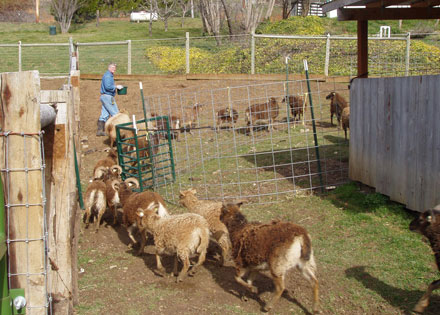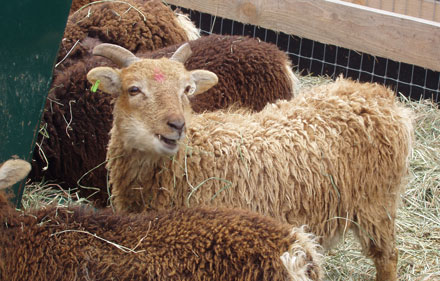Anti-tetanus vaccinations for Soay sheep: An ounce of prevention
Actually, it’s not an ounce, rather 2 cc’s, but “cc” doesn’t roll off the tongue quite as well, does it?
If by any chance you do not vaccinate your Soay sheep against clostridial diseases, you should start now. This is one of the few areas where I cannot help nagging. The sight of an animal in the throes of tetanus is truly ugly and heart-wrenching, and easily preventable.
You can read about chilling vaccine, shaking it often, the nitty gritty of the actual vaccine on more technical sites. What you will not find on the pharmaceutical pages is how to make the process shepherd-friendly. Read on.
Scheduling. We follow conventional wisdom from other breeders and aim to vaccinate about 30 days in advance of lambing. On this schedule, the ewes’ immunity level is freshly boosted and their colostrum at the maximum level of antibodies for the newborn lambs. Plus, having a set calendar allows us to pretend our lives are in order, the same sort of harmless illusion of control we get by changing batteries on the smoke alarms each year when Daylight Savings Time kicks in.
Catching. Use your trusty grain bucket, the Soay shepherd’s best friend (well, maybe second-best after blue gloves), to get the ewes off the pasture and into catchpens. In case you doubt the effectiveness of a strategically-placed bucket of grain, have a look at Steve last Sunday doing his imitation of the Pied Piper.

Confinement. Tranquility is the goal here. The last thing you want is for general panic to set in; therein lies both madness and broken horns. Aim for the smallest possible enclosure. We used to put all our girls into our 8 x 12-foot shelters and even they were too spacious. This time around we processed 5-7 ewes at a time in an enclosure no bigger than 5 x 4 feet made from our trusty Shaul panels, just room for the person giving the vaccinations. Since I was the paperwork processor and Steve was the hands-on guy, I will let him describe what he did.
“Once I get the ewes in a small space, I stand still among them, then calmly reach out and touch one of them, on her horn if possible, or around her neck. If they can’t go anywhere, they will accept my touch without undue alarm. What I want to avoid is anything that will start a chase. If they cannot run, they accept their fate.”
Seating the ewe. Working one standing ewe is enough to convince any sane shepherd that converting the ewe from a four-footed animal to a sitting duck is the only way to go when vaccinating. As the observer, it seems to me the key is to keep the ewe from lurching her head and arching her back, triggering flailing behavior. Once again, I will let Steve describe how it works for the person on the front line:
“The easiest way to get access to the vaccination site on the ewe’s chest area, right behind her foreleg, is to get her sitting on her butt or, better yet, slightly off to one side on her left ‘cheek.’ I have watched shearers do this and of course they make it look easy, especially that no-good rascal in Thornbirds. Unlike the big clumsy Suffolks, Soay sheep are quick and adept at remaining upright. But I have the advantage, their small size. I just lift the ewe up until her back legs are dangling, then quickly drop her while moving slightly backwards so her hooves will point forward and she’ll land on her bum. For me it is most comfortable to let her left side rest against the inside of my left leg.”
Author’s note: where was the video camera when I needed it?
Injection-site lumps. Some sheep, perhaps one in ten, seem prone to develop marble-sized abscesses at the injection site. This is nothing to worry about except they look icky and you will fret about them no matter what I say. It seems to help avoid the lumps if you are adept enough at giving injections that the needle lies almost flat between the skin and the body wall. Try not to go straight in like a “puncture.” Once you have given the shot, immediately rub the injection site for a couple of seconds, shmooshing the vaccine away from the hole.
Marking the finished ewes. By all means mark your ewes as you work them. It is the simplest way to be sure you have not missed anybody. We use the “All-Weather Paintstik Livestock Marker” made by LA-CO Industries, should be available at your local farm supplies store. One marker will last way beyond your Soay-raising lifetime if you do not leave it in your pocket and run it through the washing machine — yuk. The slash of color on the ewes’ noses gives them a whimsical look right out of the circus clown tent, but it wears off in a few days, and who cares if they look like pregnant Bozos, anyway? Here is our fetching little tan ewe, Lime, with her pink forehead right after her vaccination last Sunday.

Extra credits. In the non-essential but useful category, we always bring along a ewe list to make sure everyone is present and accounted for. Almost without fail, we see something to make a note about, an issue needing attention or presenting a “new development” worthy of discussion over adult beverages after chores. Just this morning, in fact, I was working with some of our photos and needed to confirm whether one of our American ewes is polled or scurred. Sure enough, there in the folder of old vaccination and worming lists was a grubby note I scratched next to Millie’s name the first time we worked her in late 2004: “tiny buttons.”
A closing note on dosages. We use Covexin-8. Its label calls for an initial dose of 5cc, with boosters thereafter at 2cc. On the advice of our veterinarian, we use 2cc right from the beginning on our lambs. Five ccs seems just way too much for a 10-week old Soay lamb.
Oh yes, did you remember to set your clocks ahead last night?
For now …
Priscilla note to readers: a dear city friend wrote this spoof after visiting us and having her eyes WAY opened about farm life. Enjoy. Dear Shepherds: I am just fascinated reading about your teeney tiny little sheep. I am a grandma and live in downtown Chicago. We frequently have our grandchildren visit, and I am thinking that it would be so darling to get them a couple of these little sheep for pets. That baby Otley looks pretty cute, for one. I have a couple of questions for you. Would you be able to send them commercial air? [Priscilla note: actually, yes, we’ve done it twice!] I know that the airlines fly dogs in the cargo section. Are they small enough to fit in a cat carrier? If so, I could maybe fly out and bring them back under the seat. Do you think I should get a boy and girl, so maybe we could start our own flock? Our floors are wooden, and so I wonder if you could recommend any hoof covers because I don’t want them to ruin the floors. I thought that we could take them into the park to eat some grass. Do they like lettuce and carrots for times when we can’t get them to the park? Also, is is possible to train them to go in a box? If not, that is no problem, because we can just set aside one room in the condo for them. I am so excited about this. I can just see my little darling grandchildren playing with these new little sheep. None of their friends will have such unique pets. Oh, one more thing. I want to teach the “grands” responsibility, so wonder if you know about special leashes for sheep. It is kind of hard to get this information in downtown Chicago. Also, do you know any vets in this area who would be good to contact for well pet care? Sorry to ask so many questions, and hope things are going well out at your wonderful farm. Once you get me the information, we can talk about price, but this part does not concern me to much. Thanks for all the help. Patti